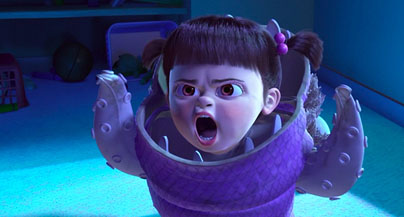Classic Movie Review: Monsters, Inc.
By Edwin Davies
December 27, 2012
In storytelling, there is a tendency to place too much emphasis on endings as indicators of quality. One of the chief criticisms of The Lord of the Rings: The Return of the King is that it's a film that ends four times before it actually finishes, and even the most ardent fans of Stephen King tend to agree that his books are great right until something dumb like a giant spider shows up in place of an actual finale. These might not invalidate the rest of the story being told, which could still be a hugely enjoyable, even beautiful experience up until that point (though if you found the preceding nine hours of little people walking through lovely locations to be interminable, I can easily see why Return of the King's stuttering finale would be hellish) but since endings are what an audience takes away, they'll be the thing that they remember most clearly.
This is why a perfect ending - one that not only resolves the plot but also the thematic and emotional undercurrents - is so rare. Endings are hard to get right, and that's why most films do well if they can end in a way which is merely okay, rather than one which sours the whole experience. Pixar's Monsters, Inc., which got a 3D re-release this past week, boasts one such perfect ending, and possibly the best ending from a company that has shown a preternatural knack for knowing exactly how to end their stories. It's so perfect, that when it was announced that a prequel was in the works, I almost jumped for joy, despite my keen awareness of how utterly terrible prequels tend to be. As long as Pixar wasn't going to mar the ending of Monsters, Inc. by showing what happened afterwards, they could do anything they liked.
But a great ending requires a good set-up. A film could have the most transcendentally beautiful/hilarious/terrifying final five minutes, but it would all be for naught if the audience walked out during the first 85. To that end, Monsters, Inc. has one of the simplest, most effective premises imaginable: what if there really are monsters in the closet, and what if scaring children was their job? It's essentially the same basic idea behind Toy Story - taking a common childhood theory of how the world works and running with it - though Monsters, Inc. was the first film to demonstrate the kind of scope that Pixar was capable of, creating an entire universe accessible through plain, unassuming doors in everyday homes (which, incidentally, doubles as a potent metaphor for the magic of art).
Through those doors live Sulley (John Goodman) and Mike Wazowski (Billy Crystal), a team of Scarers who work for the titular corporation. Their job is to go into children's bedrooms at night and scare them, then collect their screams, which in turn are converted into power for the people of Monstropolis. Sulley is especially good at his job, having become the top Scarer despite the best efforts of his main rival, Randall (Steve Buscemi), who has resorted to going in after hours and using the special doors connecting Monstropolis to the human world to boost his numbers. Sulley discovers this when he happens across a still active door, as well as the child it belongs to. Believing, as all monsters do, that children are deadly and exposure to them could be fatal, Sulley freaks out, but winds up taking the child, who he names Boo (Mary Gibbs) after the door gets deactivated and sent away, stranding Boo with Sulley.
Continued:
1
2




